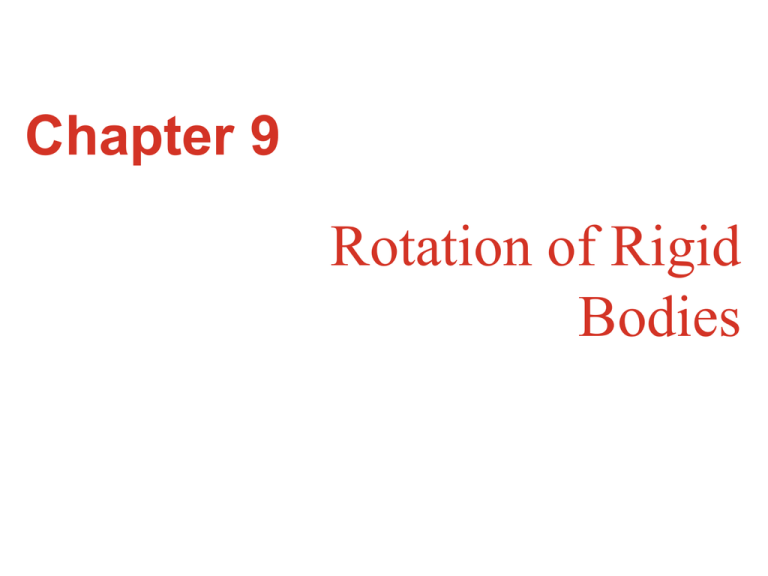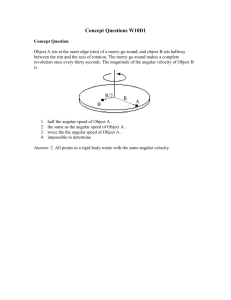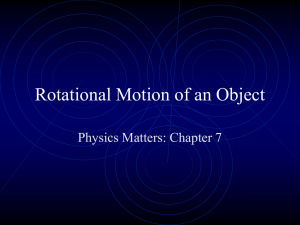ch 9 - Rotation of Rigid Bodies
advertisement

Chapter 9 Rotation of Rigid Bodies Goals for Chapter 9 • To study rotational kinematics • To relate linear to angular kinematics • To define moments of inertia and determine rotational kinetic energy • To calculate the moment of inertia Introduction • As you listen to a CD, watch a DVD, ride an airplane, or do anything that involves objects that turn in circles, you’re already involved in the process of rotational dynamics and rotational kinematics. • “Real-world” rotations can be very complicated because of stretching and twisting of the rotating object. We can make a substantial start in our understanding by studying the ideal situation of rigid bodies rotating. 9.1 Angular Velocity and Acceleration • A car’s analog speedometer gives us a very good example to begin defining rotational motion. Consider the counterclockwise motion of a rigid, fixed-length speedometer needle about a fixed pivot point. Counterclockwise is positive, clockwise is negative. Angular motions in revolutions, degrees, and radians • One complete cycle of 360° is one revolution. • One complete revolution is 2π radians. • Relating the two, 360° = 2 π radians or 1 radian = 57.3°. • An angle in radian is the ratio of two lengths (arc / radius), so it is a pure number, without dimension. s r s r Angular displacement is the angle being swept out • Like a second hand sweeping around a clock, a radius vector will travel through a displacement of degrees, radians, or revolutions. • We denote angular displacement as θ (theta). It is the angular equivalent of x or y in earlier chapters. Average Angular Velocity • The angular velocity is the angle swept out divided by the time it took to sweep out the angular displacement. • Angular velocity is denoted by the symbol ω (omega). • Angular velocity is measured in radians per second (SI standard) as well as other measures such as rpm 1 rev/min 1 rpm av z 2 1 t 2 t1 2 rad/s 60 t The subscript z indicates that the body is rotating about the z-axis, which is perpendicular to the plane of the diagram. Instantaneous Angular Velocity and Angular Speed The instantaneous angular velocity ωz use the limit of ωav-z as ∆t approaches zero – that is, the derivative of θ with respect to t: d z lim t 0 t dt When we refer simply to “angular velocity,” we mean the instantaneous angular velocity, not the average angular velocity. The angular speed ω, is the magnitude of angular velocity. Like ordinary (linear) speed v the angular speed is never negative. CAUTION: angular velocity vs. linear velocity • Angular velocity ωz and ordinary velocity, or linear velocity, vx are different. If an object has velocity vx, the object as a whole is moving along the x-axis. By contrast, if an object has an angular velocity ωz, then it is rotating around the z-axis. It is not moving along the z-axis. • Different points on a rotating rigid body move different distances in a given time interval, depending on how far the point lies from the rotation axis. However, all points rotate through the same angle in the same time. Hence at any instant, every part of a rotating rigid body has the same angular velocity. The angular velocity is positive if the body is rotating counterclockwise and negative if it is rotating clockwise. Example 9.1 calculating angular velocity The flywheel of a prototype car engine is under test. The angular position θ of the flywheel is given by θ = (2.0 rad/s3)t3 The diameter of the flywheel is 0.36 m. a. Find the angle θ, in radians and in degrees, at time t1 = 2.0 s and t2 = 5.0 s. b. Find the distance that a particle on the rim moves during that time interval. c. Find the average angular velocity, in rad/s and in rev/min (rpm), between t1 = 2.0 s and t2 = 5.0 s d. Find the instantaneous angular velocity at time t = t2 = 5.0 s Angular velocity is a vector • You can visualize the position of the vector by sweeping out the angle with the fingers of your right hand. The position of your thumb will be the position of the angular velocity vector. This is called the “right-hand rule.” Angular acceleration • The angular acceleration is the change of angular velocity divided by the time interval during which the change occurred. The symbol α (alpha) is used to denote angular acceleration (radians per second2) The instantaneous angular acceleration αz is the limit of αav-z as ∆t approaches to zero: z d z z lim t 0 t dt d d d 2 z 2 dt dt dt Angular acceleration is a vector • The angular acceleration vector will be parallel or antiparallel to the angular velocity vector (as determined by the RHR). Example 9.2 Calculating angular acceleration In example 9.1 we found that the instantaneous angular velocity ωz of the flywheel at any time t is given by ωz = (6.0 rad/s3)t2 a. Find the average angular acceleration between t1 = 2.0 s and t2 = 5.0 s. b. Find the instantaneous angular acceleration at time t2 = 5.0 s Test Your Understanding 9.1 The figure shows a graph of ωz and αz versus time for a particular rotating body. a. During which time intervals is the rotation speeding up? i. 0 < t < 2 s; ii. 2 s < t < 4 s; iii.4 s < t < 6 s. b. During which time intervals is the rotation slowing down? i. 0 < t < 2 s; ii. 2 s < t < 4 s; iii.4 s < t < 6 s. 9.2 Rotation with Constant Angular Acceleration Example 9.3 Rotation with constant angular acceleration You have just finished watching a movie on DVD and the disc is slowing to a stop. The angular velocity of the disc at t = 0 is 27.5 rad/s and its angular acceleration is a constant -100 rad/s2. A line PQ on the surface of the disc lies along the +x-axis at t = 0. a.What is the disc’s angular velocity at t = 0.300 s? b.What angle does the line PQ make with the +x-axis at this time? Test Your Understanding 9.2 Suppose the DVD in Example 9.3 was initially spinning at twice the rate and slowed down at twice the rate a.Compared to the situation in Example 9.3, how long would it take the DVD to come to a stop? i. The same amount of time ii. Twice as much time iii.4 times as much time iv.½ as much time v. ¼ as much time b. Compared to the situation in Example 9.3, through how many revolutions would the DVD rotate before coming to a stop? i. The same number of revolutions ii. Twice as many revolutions iii.4 times as many revolutions; iv.½ as many revolutions; v. ¼ as many revolutions. 9.3 Relating Linear and angular kinematics s = rθ ds d r dt dt v = rω The farther a point is from the axis, the greater its linear speed. The directions of the linear velocity vector is tangent to its circular path at each point. CAUTION: Speed vs. velocity • Linear speed v and angular speed ω are never negative, they are the magnitudes of the vectors v and ω, respectively, and their values tell you only how fast a particle is moving (v) or how fast a body is rotating (ω). • The corresponding quantities with subscripts, vx and ωz, can be either positive or negative; their signs tell you the direction of the motion. Linear Acceleration in Rigid-Body Rotation - atan The acceleration of a particle moving in a circle has its centripetal and tangential components, arad and atan. atan is the component parallel to the instantaneous velocity, acts to change the magnitude of the particle’s velocity and is equal to the rate of change of speed. This component of a particle’s acceleration is always tangent to the circular path of the particle. atan dv d r r dt dt Linear Acceleration in Rigid-Body Rotation - arad • arad is the centripetal component of acceleration, which is associated with the change of direction of the particle’s velocity. arad is always directed toward the rotation axis. arad v 2 (r ) 2 r 2 r r This is true at each instant, even when ω and v are not constant. The vector sum of the centripetal and tangential components of acceleration of a particle in a rotating body is the linear acceleration a CAUTION: Use angles in radians in all equations • When you use the equations involving rotational motion, you must express the angular quantities in radian, not revolutions or degrees. Example 9.4 Throwing a discus A discus thrower moves the discus in a circle of radius 80.0 cm. at a certain instant, the thrower is spinning at an angular speed of 10.0 rad/s and the angular speed is increasing at 50.0 rad/s2. at this instant, find the tangential and centripetal components of the acceleration of the discus and the magnitude of the acceleration. Example 9.5 Designing a propeller Your are asked to design an airplane propeller to turn at 2400 rpm. The forward airspeed of the plane is to be 75.0 m/s and the speed of the tips of the propeller blades through the air must not exceed 270 m/s. a. What is the maximum radius the propeller can have? b. With this radius, what is the acceleration of the propeller tip? Example 9.6 Bicycle gears • How are the angular speeds of the two bicycle sprockets related to the number of teeth on each sprocket? Test Your Understanding 9.3 • Information is stored on a CD or DVD in a coded pattern of tiny pits. The pits are arranged in a track that spirals outward toward the rim of the disc. As the disc spins inside a player, the track is scanned at a constant liner speed. How must the rotation speed of the disc change as the player’s scanning head moves over the track? 1. The rotation speed must increase. 2. The rotation speed must decrease 3. The rotation speed must stay the same. 9.4 Energy in Rotational Motion • A rotating rigid body has kinetic energy. We can express this kinetic energy in terms of the body’s angular speed and a new quantity, called moment of inertia. Which depends on the body’s mass and how the mass is distributed. • Let’s consider a body as being made up of large number of particles, with masses m1, m2, … at distances r1, r2, … from the axis of rotation. We label the particles with the index i: the mass of the i th particle mi and is distance from the axis of rotation is ri, where ri is the perpendicular distance from the axis to the i th particle. When a rigid body rotates about a fixed axis, the speed vi of the ith particle is given by vi = riω, where ω is the body’s angular speed. Different particles have different values of ri but ω is the same for all. The kinetic energy of the ith particle is Ki = ½ mivi2 = ½ miri2ω2 The total kinetic energy of the body is the sum of the kinetic energies of all its particles: or The quantity obtained by multiplying the mass of each particle by the square of its distance from the axis of rotation and adding these products, is denoted by I and is called the moment of inertia of the body for this rotation axis: The SI unit of moment of inertia is the kilogram-meter2 (kg∙m2) Moment of Inertia depends on the distance from the axis • For a body with a given rotation axis and a given total mass, the greater the distance from the axis to the particles that make up the body, the greater the moment of inertia. • Since kinetic energy of a body equals the amount of work done to accelerate that body from rest, so the greater a body’s moment of inertia, the harder it is to start the body rotating it it’s at rest and the harder it is to stop its rotation it it’s already rotating. K = ½ I∙ω2 • To use this equation, ω must be measured in radians per second, not revolutions or degrees per second, to give K in joules. According to the equation, the greater the moment of inertia, the greater the kinetic energy of a rigid body rotating with a given angular speed ω. Example 9.7 Moments of inertial for different rotation axes An engineer is designing a machine part consisting of three heavy disks linked by lightweight struts. a.What is the moment of inertial of this body about an axis through the center of disk A, perpendicular to the plane of the diagram b.What is the moment of inertia about an axis through the centers of disks B and C? c.If the body rotates about an axis through A perpendicular to the plane of the diagram, with angular speed ω = 4.0 rad/s, what is its kinetic energy? CAUTION: Moment of inertia depends on the choice of axis • From the results of the example, we can conclude that the moment of inertial of a body depends on the location and orientation of the axis. • It’s not enough to just say, “the moment of inertia of this body is 0.048 kg∙m2.” we have to be specific and say, “the moment of inertia of this body about the axis through B and C is 0.048 kg∙m2.” When the body is a continuous distribution of matter, such as a solid cylinder or plate, the sum becomes an integral, and we need to use calculus to calculate the moment of inertia. Finding the moment of inertia for common shapes CAUTION: Computing the moment of inertia • You may be tempted to try to compute the moment of inertia of a body by assuming that all the mass is concentrated at the center of mass and multiplying the total mass by the square of the distance from the center of mass the axis, Resist the temptation; it doesn’t work! • For example, when a uniform thin rod of length L and mass M is pivoted about an axis through one end, perpendicular to the rod, the moment of inertial is I = ML2/3. If we took the mass as concentrated at the center, a distance L/2 from the axis, we would obtain the incorrect result I = M(L/2)2 = ML2/4 Example 9.8 An unwinding cable I A light, flexible, non-stretching cable is wrapped several times around a winch drum, a solid cylinder of mass 50 kg and diameter 0.120 m, which rotates about a stationary horizontal axis held by frictionless bearings. The free end of the cable is pulled with a constant 9.0 N force for a distance of 2.0 m. It unwinds without slipping and turns the cylinder. If the cylinder is initially at rest, find its final angular speed and the final speed of the cable. 20 rad/s 1.2 m/s Example 9.9 an unwinding cable II We wrap a light, flexible cable around a solid cylinder with mass M and radius R. The cylinder rotates with negligible friction about a stationary horizontal axis. We tie the free end of the cable to a block of mass m and release the object with no initial velocity at a distance h above the floor. As the block falls, the cable unwinds without stretching or slipping, turning the cylinder. Find the speed of the falling block and the angular speed of the cylinder just as the block strikes the floor. Gravitational Potential Energy for an Extended Body • If the acceleration of gravity g is the same at all points on the body, the gravitational potential energy is the same as though all the mass were concentrated at the center of mass of the body. U Mgycm Test Your Understanding 9.4 Suppose the cylinder and block in Example 9.9 have the same mass. Just before the block strikes the floor, which statement is correct about the relationship between the kinetic energy of the falling block and the rotational kinetic energy of the cylinder? i. The block has more kinetic energy than the cylinder. ii. The block has less kinetic energy than the cylinder. iii.The block and the cylinder have equal amounts of kinetic energy. 9.5 Parallel-Axis Theorem • A body doesn’t have just one moment of inertia. If fact, it has infinitely many, because there are infinitely many axes about which it might rotate. The relationship between the moment of inertial Icm of a body of mass M about an axis through its center of mass and the moment of inertia Ip about any other axis parallel to the original one but displaced from it by a distance d is called the parallelaxis theorem: I p I cm Md 2 Example 9.10 Using the parallel-axis theorem A part of a mechanical linkage has a mss of 3.6 kg. We measure its moment of inertia about an axis 0.15 m from its center of mass to be Ip = 0.132 kg∙m2. What is the moment of inertia Icm about a parallel axis through the center of mass? Test Your Understanding 9.5 • A pool cue is a wooden rod with a uniform composition and tapered with a larger diameter at one end than at the other end. Use the parallel-axis theorem to decide whether a pool cue has a larger moment of inertia i. For an axis through the thicker end of the rod and perpendicular to the length of the rod ii. For an axis through the thinner end of the rod and perpendicular to the length of the rod.









